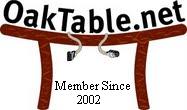I blogged yesterday about Oracle over NFS performance and NFS protocol for Oracle. In the post I referenced a recent thead on comp.databases.oracle.server where Oracle over NFS performance was brought into question by a list participant. I addressed that in yesterday’s blog entry. The same individual that questioned Oracle NFS performance also called for proof that Oracle supports using large files in an NFS mount as “disks” in an ASM disk group. I didn’t care to post the reply in c.d.o.s because I’m afraid only about 42 people would ever see the information.
Using ASM on NAS (NFS)
I’ve blogged before about how I think that is a generally odd idea, but there may be cases where it is desirable to do so. In fact, it would be required for RAC on Standard Edition. The point is that Oracle does support it. I find it odd actually that I have to provide a reference as evidence that such a technology combination is supported. No matter, here is the reference:
Oracle Documentation about using NAS devices says:
C.3 Creating Files on a NAS Device for Use with Automatic Storage Management
If you have a certified NAS storage device, you can create zero-padded files in an NFS mounted directory and use those files as disk devices in an Automatic Storage Management disk group. To create these files, follow these steps:
Note:
To use files as disk devices in an Automatic Storage Management disk group, the files must be on an NFS mounted file system. You cannot use files on local file systems.
A Dirty Little Trick
If you want to play with ASM, there is an undocumented initialization parameter that enables the server to use ASM with normal filesystem files. The parameter is called _asm_allow_only_raw_disks. Setting it to FALSE allows one to test ASM using zero-filled files in any normal filesystem. And, no, it is not supported in production.
More Information
For more information about ASM on NAS, I recommend:


The document you reference says the device has to be certified. That points to a document that says “Oracle and its partners worked together to validate specialized storage technology including NFS file servers, remote mirroring, and snapshot products.
At this time Oracle believes that these three specialized storage technologies are well understood by the customers, are very mature, and the Oracle technology requirements are well know. As of January, 2007, Oracle will no longer validate these products.”
Note:183408.1 says “The following common technologies to share data can not be used for a Real
Application Cluster database:
– NFS (as Unix Service, note the difference to NAS)”
I’d say quoting from docs is ambiguous, at best.
As far as only 42 people on cdos, that would be enough for life, the universe, and everything.
🙂
Sounds like a google interview question – how do you count the number of lurkers on a newsgroup?
What I’m thinking – and I could be very, very wrong here, I’ll freely admit – is that ASM over NFS gives you one pretty cool advantage.
I can pick up a couple of decent yet inexpensive NFS-serving units, like Dell’s AX150i. Then use ASM to create redundant volumes (pardon the terminology, I forget which it uses) on them. That would, I believe, give me a zero-point-of-failure system pretty cheaply.
Using real-world pricing, I can grab a 2TB single-processor AX150i with redundant power supplies for $6,160 – with each additional 1TB costing about $980. Make it two, and for $12k and change I’ve got 2TB of totally redundant storage, supporting dual GigE interfaces to each box.
Its not the cheapest way to get to 2TB I’ll grant you, but it is a pretty decent way to get ever-closer to 100% uptime, which is an issue with some of the big single-headed systems.
Although I can’t help but wonder how cost-efficient it would be to simply set up a bunch of white-box servers, not even using RAID internally, and use ASM to mirror everything across them. Probably more hassle than its worth… but tempting to evaluate from a stability/performance basis nonetheless.